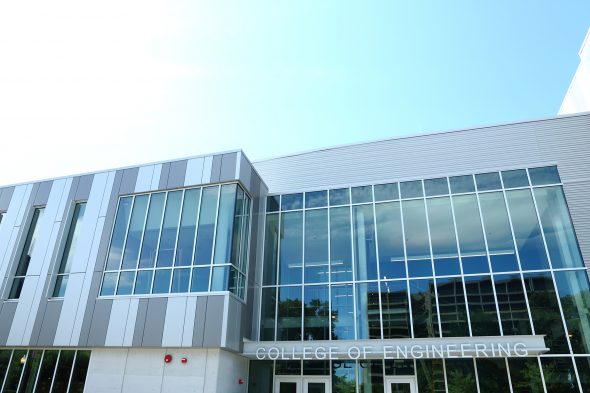UIC’s new Engineering Innovation Building supports nano- to mega-scale research and dramatic growth in engineering student enrollment
The University of Illinois at Chicago’s new 57,500-square-foot Engineering Innovation Building will add depth and breadth to the university’s expanding engineering footprint. The building will house engineers investigating phenomena on a scale from the very large — bridge and highway components — to the exceedingly small, such as nanoscale components that will drive the next generation of thermal batteries.
The chemical engineering and civil and materials engineering departments will occupy the new building, which is home to the Chicago area’s only high-bay structural research laboratory, which enables engineers and industry professionals to develop and test large and heavy infrastructural components. The chemical engineers in the new building will continue leading research work on projects including developing artificial leaves that take carbon dioxide directly from the atmosphere to make synthetic gas, microbial fuel cells and cancer detection technology that uses microfluidics devices.
“The City of Chicago and UIC share a mission not only to create success, but to ensure that success is shared, and that full participation is possible,” said Mayor Lori E. Lightfoot. “By providing opportunities to our city’s students, who are brimming with raw talent, we are inspiring Chicago’s young people to build the skills they need for the jobs they deserve regardless of their background or zip code.”
The $43 million building at the corner of Morgan and Taylor Streets highlights UIC’s investment in its rapidly growing engineering programs. Enrollment at the College of Engineering has almost doubled in the last 10 years to more than 5,000 students.
“The College of Engineering has experienced explosive growth in enrollment in the last few years, outpacing growth in demand for engineering programs nationally,” said Michael Amiridis, UIC Chancellor. “The new building supports our unprecedented growth, provides unique learning opportunities for students, attracts top academic talent and strengthens our ties with local business, industry and other partners to drive innovation in engineering in the Chicagoland area.”
The Engineering Innovation Building’s high-bay structural research lab is a unique facility in northern Illinois. Here, researchers and government agencies will be able to develop and test large-scale structural components and determine how they behave under various loads and conditions. The bay rests on a 6-foot-thick reinforced concrete slab designed to support massive pieces of infrastructure and features a 30-foot-high L-shaped reactive wall. Its equipment includes hydraulic pumps and actuators that can deliver varied dynamic loads to assess the stability of structures and to shed light on optimal designs.
“The high-bay lab is going to attract not only students and faculty but also industry partners,” said Abolfazl Mohammadian, UIC professor and head of civil and materials engineering. He noted that agencies such as the Illinois Department of Transportation, the Illinois State Toll Highway Authority and companies that are innovating new structural materials can now conduct development and testing right here in Chicago — a function of increasing importance given climate change and the rise in extreme weather.
Mohammadian said the facility can open doors to new research areas such as forensic engineering and will provide students with valuable real-world experience.
The new building includes research, classroom and office space, and it brings the chemical engineering department, which has been located off campus east of the Dan Ryan Expressway for more than 20 years, into the center of the east campus. The building is the first of two new buildings that will help accommodate the growing College of Engineering student population and innovative engineering research.
A second new building, which will house the computer science department, is slated to open in 2022. Computer science is the fastest-growing department in the university, with enrollment leaping from less than 200 in 2005 to more than 1,200 today. The computer science building will receive $98 million from the State of Illinois through the recently signed capital infrastructure bill. Governor J.B. Pritzker’s robust statewide capital program, “Rebuild Illinois,” is the state’s first capital spending plan in a decade.
“The UIC College of Engineering is well on its way to becoming a top-five public, urban engineering college, and the new Engineering Innovation Building represents another big step in that direction,” said Pete Nelson, dean of the College of Engineering. “The new building enables us to offer our students unique opportunities to learn in a state-of-the-art space that also will support Illinois companies who are eager to hire our students.”
Chemical engineering’s research portfolio at UIC has become significantly stronger in the last few years.
Vikas Berry, UIC professor and head of chemical engineering, is looking forward to using a one-of-a-kind, high-tech classroom that overlooks a unit-operations lab that serves as a model chemical plant, where students can observe real chemical operations as they learn the related concepts.
“We are addressing the world’s water and energy crises via our research in membrane purification, artificial photosynthesis, molecular photovoltaics, thermal batteries and fuel cells,” Berry said. “We are also leading the work on drug delivery, cancer detection, biocompatible surfaces, complex fluids, 3D printing and nanoelectronics. The department has world-class talent, and now it will have world-class facilities.”
In addition to facilitating research, the building’s labs will support a new undergraduate concentration in molecular nanotechnology that the College of Engineering hopes to offer by fall 2020.
The building was designed by Dewberry architects and built by Berglund Construction and is expected to be LEED Gold certified later this year.

